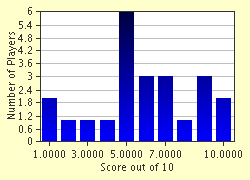Quiz Answer Key and Fun Facts
1. The graphic artist Maurits Cornelis Escher was best known professionally by his initials as M.C. Escher, but by what nickname was he generally known during his childhood?
2. M. C. Escher was born in a house that was formerly part of a royal palace and was later converted into the Princesshof Ceramics Museum. In which Dutch city would you find this notable building?
3. Which subject did M. C. Escher study in Haarlem before switching to a course on Decorative Arts?
4. 'Castrovalva', 'The Bridge' and 'Atrani, Coast of Amalfi' are among the earlier works of M. C. Escher. They were inspired by various locations in which European country where he lived from 1923 to 1935?
5. In 1936 M. C. Escher visited which Spanish building whose Moorish architecture includes the tessellated mosaic designs that provided the inspiration for much of his later work?
6. M. C. Escher's amateur interest in which scientific discipline was highlighted by his 1948 work 'Stars' - a wood engraving print depicting two caged chameleons drifting through space?
7. Given the mathematical nature of much of M. C. Escher's artwork, it is unsurprising that he corresponded with a number of prominent mathematicians. Which of these groups of people influenced, or were influenced by, Escher?
8. In 1955, M. C. Escher was awarded a knighthood in which order of chivalry?
9. In 1970 M. C. Escher moved to the Rosa Spier Huis in the Dutch town of Laren. What was it?
10. "Going up and down a staircase at the same time" is a good description of which of M. C. Escher's most famous 'impossible objects' works?
Source: Author
Fifiona81
This quiz was reviewed by FunTrivia editor
bloomsby before going online.
Any errors found in FunTrivia content are routinely corrected through our feedback system.

